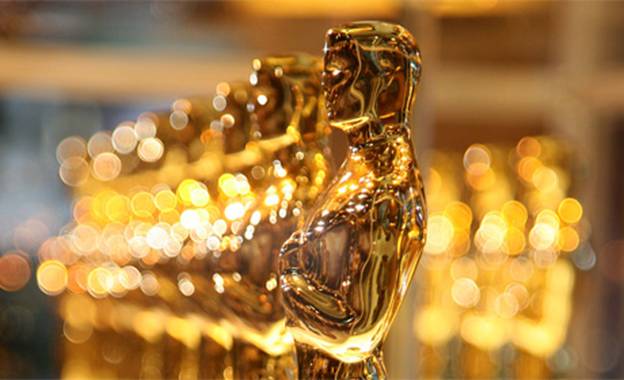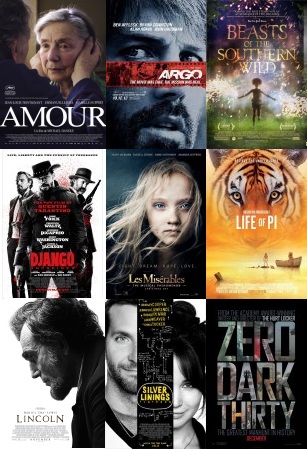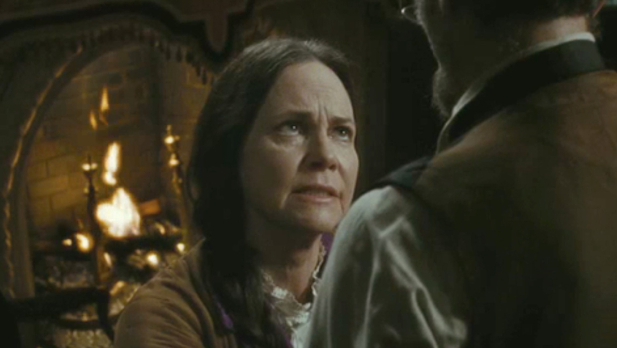Written by Megan Kearns.
When people watch movies, they often think it’s just entertainment. That they don’t really matter. But media impacts our lives tremendously. Films reflexively shape and reflect culture. Feminist commentary is vital.
Too often, films depict misogyny, sexist gender roles, damsels in distress, women killed, and women’s bodies objectified. The Oscars typically reward women for playing roles that support a central male character in films.
Only 6 black women — Hattie McDaniel (Gone with the Wind), Whoopi Goldberg (Ghost), Jennifer Hudson (Dreamgirls), Halle Berry (Monster’s Ball), Mo’Nique (Precious), Octavia Spencer (The Help) — have ever won for acting. Sadly the roles they won for are “maids, single mothers on welfare and one trickster con artist.”
In 85 years, only 7 women producers have won the Best Picture title, all as co-producers with men — Julia Phillips for (The Sting), Lili Fini Zanuck (Driving Miss Daisy), Wendy Finerman (Forrest Gump), Donna Gigliotti for (Shakespeare in Love), Fran Walsh for (The Lord of the Rings: The Return of the King), Cathy Schulman for (Crash), Kathryn Bigelow for (The Hurt Locker).
Women’s dialogue and plotlines rarely focus on other women or even themselves. If women talk to each other, it’s usually revolving around men. This is why the Bechdel Test – while not perfect or automatically indicating feminism – matters. The Bechdel Test: film must 1) feature two named female characters, 2) who talk to each other, 3) about something other than a man.
Now the Bechdel Test doesn’t measure whether or not a film is good or even if it’s feminist or female-centric. And it’s not just about judging films on an individual basis. The Bechdel Test matters because the overwhelming majority of movies fail, indicating the institutional sexism and rampant gender disparity prevalent in Hollywood.
So let’s look at each of this year’s Best Picture nominees:
The heartbreaking Amour focuses on the marriage and love between wife Anne and husband Georges after Anne suffers a stroke. Their daughter Eva and Georges argue about putting her into medical facility. Eva talks to Anne after her stroke but it’s more of a one-sided conversation. It may not pass the Bechdel Test but it’s arguably a female-centric film as Anne is often the focus.
Argo has a woman problem (and perpetuates Iranian stereotypes) as the women are pushed to the background. The two female hostages never interact with each other alone (the way the men do), only as a group, and we never really hear their opinions or views. The Canadian diplomat’s wife and their housekeeper Sahar — a pivotal female character who’s not initially trusted or credited with bravery — talk extremely briefly. Just like the other women in Argo, Sahar’s opinions and views are erased. Her importance truly lies in how she relates to men, again reifying the exultation of men.
The breathtaking and unusual Beasts of the Southern Wild boasts a unique, nuanced, fierce female protagonist of color. While the film focuses on Hushpuppy’s relationship to her father Wink, her relationship to her absent mother is equally important as we see in her wearing her jersey and searching for her. She also has conversations with her teacher Miss Bathsheeba. We often see boys and men in films that showcase a hero’s journey or transformation. But here we see a journey with a strong-willed, opinionated girl. And I couldn’t be more thrilled.
Django Unchained features a black male protagonist spurred on by “heroic love.” It’s wonderful to see a black married couple who love each other onscreen. And Django captures the “psychological and emotional terrorism” blacks endured. But from a gender perspective, women don’t interact with one another aside from a white woman ordering a female slave. Broomhilda – the catalyst of Django’s journey – is ultimately a damsel in distress rescued by her husband.
Les Miserables boasts feminist themes showcasing plight of women – poverty, sacrifice, sexual slavery. Fantine is a pivotal character. While Eponine and Cossette are in the film, they never interact with each other. Rather there’s a love triangle with Marius in the middle. Despite the large cast of characters, Les Mis ultimately revolves around Jean Valjean – one man’s redemption and salvation.
While his mother impacts his life throughout the film, Life of Pi revolves around an Indian boy’s survival on a shipwrecked boat with a tiger and his search for religion and spirituality.
Obviously, Lincoln is about a dude….Lincoln. And yes, his wife Mary Todd Lincoln is depicted as “his intellectual equal.” But again she revolves around him. Also the film whitewashes the abolition of slavery with the omission of Frederick Douglass. Really? How the hell can you discuss abolition without Douglass?? Even when we do see two women together – Mary Todd Lincoln (Sally Field) and Elizabeth Keckley (Gloria Reuben) – they barely converse. That’s right, only white dudes have impacted or changed history.
Silver Linings Playbook features the unconventional friendship and attraction of a Tiffany and Pat, both struggling with mental illness. We learn that Tiffany is a widow who’s been on medication with an unnamed illness. We see Tiffany and her sister Veronica talk with each other about their lives. I loved this movie. Jennifer Lawrence is once again an outstanding badass. And who knew Wedding Crashers’ Bradley Cooper (although I did love him as Will on Alias) was this good? I’m thrilled that we’re starting to see more nuanced portrayals of mental illness, specifically bipolar disorder – Homeland, Friday Night Lights. But when it comes to gender, while Tiffany is complicated, confident and vulnerable, we get a few details here and there about her life. The predominant focus remains on Pat.
The most controversial (and outstanding) film of the year, Zero Dark Thirty revolves around a strong, complex, intelligent female protagonist. Many have disputed its feminism because they believe it condones torture. While it doesn’t condemn torture is vehemently as it could or should, it raises complex questions. Throughout the film, Bigelow shows that not only does she not condone torture, but ultimately makes a bold and damning statement against the U.S.’ War on Terror. Friends Maya and Jessica debate strategy, challenge each other and unwind. Zero Dark Thirty makes an interesting commentary on gender politics, showcases female friendship and a complex female protagonist struggling to assert her voice in a male-dominated world.
So 3 films pass the Bechdel Test. It’s interesting, although not surprising, that two of those films, which are the most female-centric films nominated this year – Beasts of the Southern Wild and Zero Dark Thirty – are also the two with a woman co-screenwriter or woman director.
I’m really, really, really tired of the white dudefest.
It’s really hard to ignore the correlation between the lack of female-centric films and how few women write and direct.
Of the top 250 grossing films in the U.S. in 2012, 9% of directors were women and 15% were writers. Women 18% of all directors, executive producers, producers, writers, cinematographers, and editors working on top 250 films. Only 33% of films’ speaking roles belong to women
Despite the fact that women buy 50% of movie theatre tickets (as of 2010), most films feature male protagonists. When a female character exists, usually she’s some guy’s lover, spouse or sidekick. Or she’s the damsel in distress he’s going to rescue, validating his virility and masculinity. Male characters do talk about women but they exist as one topic in the spectrum of dialogue. When we see female characters, they serve as “damsels in distress, pining spinsters, fighting fuck toys,” sexy seductresses or “manic pixie dream girls.” Men’s films are seen as universal. Women’s films are seen as niche. That has to change.
All of these objectifying tropes exist for the male gaze, implying that women’s lives must revolve around men. We need to see more women on-screen and behind the scenes. Hopefully then we’ll see more diversity in female characters in age, class, race, sexual orientation as well as personality traits.
“People don’t think about whether a film is directed by a man or a woman. We need to help folks understand why it is important. We need to make people understand in terms they can process about the gender disparities in Hollywood. People don’t think about whether a film is directed by a man or a woman. We need to help folks understand why it is important.”
“Taking on the big bad Oscars is important, but so is doing our part as individuals to support women filmmakers. Write about them. Independent filmmakers need actual support — reviews they can show distributors, social media buzz to coax funders.”
Women’s stories matter. Women’s voices must be heard. It’s long overdue for the Oscars to realize that too.





.jpg)